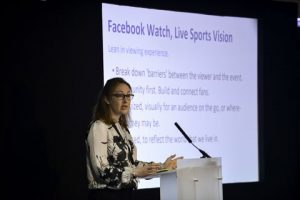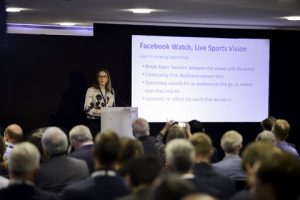SportTech 2018: Facebook shows it wants to be more than just friends with sports fans
As social media platforms up their game in the pursuit of live-streamed sporting events, broadcasters and sports rights-owners and holders are just as keen to extend their viewer and fan base, as well as their marketing reach. But how exactly does it manifest itself in the real world?
At SVG Europe’s SportTech event on 30 May at Chelsea Football Club in London, Melissa Lawton, head of live sports production strategy at Facebook, provided a unique insight into the relationship between the sports industry and Facebook, exploring editorial considerations, fan engagement and production techniques, including the merging of social and traditional production teams.

Speaking on stage to Will Strauss, SVG Europe contributing editor, Lawton first looked at Facebook Watch, the new platform for video that will be the central place for broadcasters, rights holders and creators to distribute their sports content. Watch is where Facebook’s partners can build predictable, loyal audiences and cultivate community and conversation around the content they are creating, as well as where people can come back to time and again to discover video content and build a habit of watching long form vide , Lawton noted, although she added it is currently only available in the US.
With regard to live sports, Lawton stated that it is important to break down barriers between the viewer and the event by thinking about community first, building and connecting with fans, making sure content is optimised visually for an audience on the go or wherever they may be, as well as being localised.
The focus for Facebook is, she said, on three key areas: clear and readable graphics that are optimised for mobile; coordinated commentary; and community management.
Graphics is a real issue for sports broadcasters to get their heads around, Lawton said. Rethinking screen real estate is important due to the number of devices that people view sport on, from laptops to tablets and smartphones. This means the real estate of the screen goes from large to very small, so graphics in the top left hand corner, as per TV, do not work well as they block images. Also, with Facebook Watch, viewers are able to talk to each other as the action goes on, which can cause problems by blocking action at the bottom of the screen, for instance, the hole being aimed at in a golf tournament.

Facebook’s Melissa Lawton speaking at SportTech 2018
As a result of these issues, Facebook recommends that the top right corner is the cleanest area for score bugs and the like. Meanwhile, for vertical video, bottom right is best, for graphics and viewer chat.
Lawton commented: “We know more and more people are watching content on mobile devices. Really, as broadcasters, producers and content makers, you need to think of that on-screen real estate.”
Data graphics are still important for Facebook Watch, because as well as providing a helpful role, guiding the action, on a small screen, they are something that younger viewers have been bought up with and actively expect to see on live content.
Wide screen shots work on TV, but as the screen sport is being viewed on gets smaller, close-up shots of athletes faces, showing the emotion of the event, actually work better, Lawton said. “You need to look at reframing this for the small screen,” Lawton noted. She said that while wise shots have their place on the small screen to set up location and layout, tight shots keep viewers inside the live action.”
On coordinated commentary, co-ordination between host, chat and graphics is key. What is needed, Lawton said, is the need to change end to end production workflows, to open communication channels with social teams, to use a social producer to surface chat comments, to consider whether you need to use third party tools, and to use a commentary team who understand social tools.

On another note, Lawton said what is key on Facebook is allowing fans to have their say in a meaningful way. This can include putting an athlete, analyst or similar person into the chat live to answer fans questions on Facebook as the live match goes on, providing great interaction opportunities. You can also interview stars and key players using fan questions, while using a split screen to keep the live action as well as the interview action going for the fans concurrently. She added: “The engagement and excitement you get from that really drives participation.”
In terms of managing this kind of process, Lawton recommended getting all ducks lined up in a row beforehand, so getting photos and videos prepped before a live game as well as a plan of how to roll those out within the live event, for maximum impact. She added that social voting and hashtag campaigns are also useful ways of engaging viewers during a live event.
